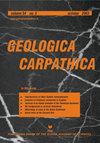挪威西部Gneiss地区Otrøy的Midsund麻粒岩的减压平衡
IF 1.5
4区 地球科学
Q4 GEOSCIENCES, MULTIDISCIPLINARY
引用次数: 2
摘要
摘要斯堪的纳维亚喀里多尼亚山脉的西部片麻岩区(WGR)是高压(HP)和超高压(UHP)变质作用的典型地形。然而,那里出现的绝大多数岩性没有或只有有限的HP或UHP变质作用的证据。所研究的Midsound HP麻粒岩产于Otrøy岛,该地区以超高压榴辉岩和地幔衍生的含石榴石超镁铁质岩的出现而闻名。Midsund麻粒岩由斜长石、石榴石、单斜辉石、残留的粉英云母、黑云母、金红石、石英、角闪石、钛铁矿和钛矿组成,是最突出的相。NCKFMMnASHT系统中应用的热力学建模产生了一个压力-温度(P–T)假截面,该假截面提供了石榴石中XMg(Mg/Mg+Fe)、斜长石中钠长石和斜辉石中XNa(Na/Na+Ca)的组成等值线在熔体+斜长石+石榴石+斜辉石+角闪石+钛铁矿的稳定性场中的交点。所获得的热力学模型产生了1.32–1.45 GPa和875–970°C的P–T条件。Midsund麻粒岩记录的相对较高的P–T可能被解释为由于HP(推测为UHP)条件下的剥露而产生的平衡效应,随后在中低地壳水平的HT下出现一段停滞期。后者似乎是WGR中比以前认为的更普遍的现象,很可能解释了WGR中相邻岩性与世界各地其他HP–UHP地体之间通常计算的压力对比。本文章由计算机程序翻译,如有差异,请以英文原文为准。
Decompressional equilibration of the Midsund granulite from Otrøy, Western Gneiss Region, Norway
Abstract The Western Gneiss Region (WGR) of the Scandinavian Caledonides is an archetypal terrain for high-pressure (HP) and ultrahigh-pressure (UHP) metamorphism. However, the vast majority of lithologies occurring there bear no, or only limited, evidence for HP or UHP metamorphism. The studied Midsund HP granulite occurs on the island of Otrøy, a locality known for the occurrence of the UHP eclogites and mantle-derived, garnet-bearing ultramafics. The Midsund granulite consists of plagioclase, garnet, clinopyroxene, relict phengitic mica, biotite, rutile, quartz, amphibole, ilmenite and titanite, among the most prominent phases. Applied thermodynamic modelling in the NCKFMMnASHT system resulted in a pressure–temperature (P–T) pseudosection that provides an intersection of compositional isopleths of XMg (Mg/Mg+Fe) in garnet, albite in plagioclase and XNa (Na/Na+Ca) in clinopyroxene in the stability field of melt + plagioclase + garnet + clinopyroxene + amphibole + ilmenite. The obtained thermodynamic model yields P–T conditions of 1.32–1.45 GPa and 875–970 °C. The relatively high P–T recorded by the Midsund granulite may be explained as an effect of equilibration due to exhumation from HP (presumably UHP) conditions followed by a period of stagnation under HT at lower-to-medium crustal level. The latter seems to be a more widespread phenomenon in the WGR than previously thought and may well explain commonly calculated pressure contrasts between neighboring lithologies in the WGR and other HP–UHP terranes worldwide.
求助全文
通过发布文献求助,成功后即可免费获取论文全文。
去求助
来源期刊

Geologica Carpathica
地学-地球科学综合
CiteScore
2.40
自引率
23.10%
发文量
26
审稿时长
>12 weeks
期刊介绍:
GEOLOGICA CARPATHICA covers a wide spectrum of geological disciplines including geodynamics, tectonics and structural geology, volcanology, stratigraphy, geochronology and isotopic geology, karstology, geochemistry, mineralogy, petrology, lithology and sedimentology, paleogeography, paleoecology, paleobiology and paleontology, paleomagnetism, magnetostratigraphy and other branches of applied geophysics, economic and environmental geology, experimental and theoretical geoscientific studies. Geologica Carpathica , with its 60 year old tradition, presents high-quality research papers devoted to all aspects not only of the Alpine-Carpathian-Balkanian geoscience but also with adjacent regions originated from the Mediterranean Tethys and its continental foreland. Geologica Carpathica is an Official Journal of the Carpathian-Balkan Geological Association.
 求助内容:
求助内容: 应助结果提醒方式:
应助结果提醒方式:


